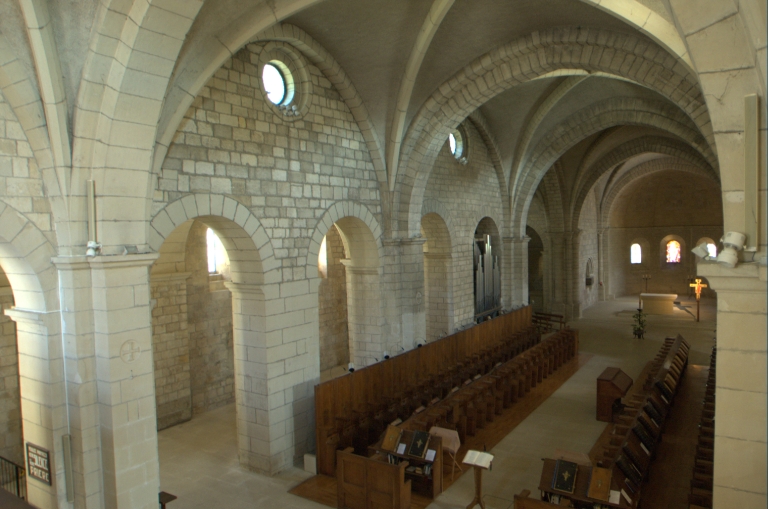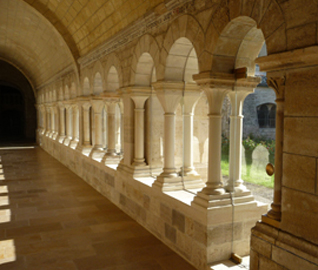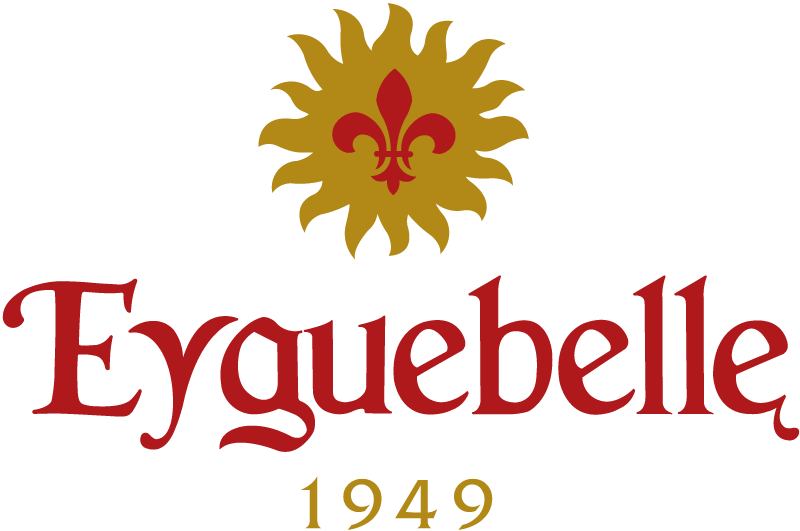
Aiguebelle Abbey, a Cistercian monastery with a rich history, has seen many events since it was founded in the 12th century, in 1137 to be exact. Discover its thousand-year-old history, its architectural treasures and the activities on offer for an enriching visit.
Notre-Dame d'Aiguebelle Abbey: a testimony to Cistercian history
On 26 June 1137, on the border between Dauphiné and Provence, the Cistercian monks of Morimond Abbey founded Aiguebelle Abbey.
The monastery had the advantage of being built at the bottom of an isolated valley, at the confluence of three streams: a source of energy, hence the name Aiguebelle, ‘aqua bella’ in Latin, beautiful water, pure water.
The thousand-year-old history of the abbey
The rule of life of a Cistercian monk (Benedictine monks returning to the purity of the rule of St Benedict) is prayer, but also work, unlike other religious orders. A Cistercian monk must support himself. In those days, the lords bought their place in heaven by offering land to the monks so that they could develop their subsistence farming (50% of the population of the time lived in monasteries). The lord of Rochefort-en-Valdaine offered 5,000 hectares to the monks of Aiguebelle. The estate thus extended as far as Mont Gerbier-de-Jonc.
In the 14th century, however, the Cistercian community suffered both the Hundred Years' War and the Black Death... This situation led to a drop in vocations, particularly among the lay brothers, who looked after the fields and harvests. The brothers were therefore forced to rent out most of their land. From 1515, the abbots were no longer elected by the monks, but appointed by the king: these were the abbots commendataires, outside the monastery, who did not always look after the needs of their monks or the fervour of their community. When the monks were dispersed in 1791, there were only three of them left. The monastery was plundered and sold as national property. The fact that it was far from the main roads saved it from destruction.
The absence of the monks lasted less than 25 years, until 1815, with the arrival of a group of Trappist monks from the French abbey of La Trappe.
The community of Aiguebelle Abbey grew rapidly from that date onwards. By 1850, it had no fewer than 230 monks. It went on to create a number of other monasteries, most of which are still in operation, notably in Morocco and Cameroon!
Their traditional activities (livestock rearing and agriculture) were taken up again, and they then enriched their production with more craft-based activities. They produce rosaries, brooms, wicker baskets and so on.
Next came two main activities, first the chocolate factory and then the distillery, which became Aiguebelle's two major industries, employing more than 250 lay workers. The spiritual, cultural and social activities of this population were managed by the monks, but given the increase in the number of workers and the vocation of a monastery, which is prayer and meditation, the various activities were stopped.
Cistercian architecture
The architecture of Aiguebelle Abbey is characterised by its Cistercian influences and its thousand-year-old history.
The must-see buildings:
The abbey church: To the north of the cloister, it faces east, as tradition dictates. Shaped like a cross, it also comprises a nave (and its aisles) and a transept (two chapels).

- The cloister: This consists of four galleries 29 metres long. It is vaulted on coupled colonnettes, topped with capitals (each unique) and a wide variety of hooks and foliage. Graffiti and inscriptions from the 14th and 15th centuries can be seen on several of them, including a funerary inscription dated 1363. Partly destroyed in 1562, the other galleries were rebuilt in the 16th century by Abbé Adrien de Bazemont, who replaced the broken columns with arcades closed by windows.

Monastic life in Aiguebelle
The Rule of Saint-Benoît: the principles of monastic life
Through his rule, written for his disciples, Saint-Benoît became the great legislator of monastic life in the West. It organises the life of the brothers according to the Gospel: ‘They must prefer nothing to the love of Christ’ (Ch. 72), present in the Abbot, each of the brothers, the sick and the guests. This rule, rich in spiritual doctrine, profound wisdom and a good knowledge of human psychology, provides us with teaching that is still as relevant today as it was in the 6th century.
The life he organised was a cenobitic life, that is, the life of a community living under a rule and an Abbot. The Abbot is the representative of Christ and the Father of the community. He is responsible for both spiritual and material matters. In the former case, he is assisted by the Father Prior and the Father Master (for the novices), and in the latter case, by the cellarer.
The monks activities: prayer, manual work, welcoming pilgrims
Notre-Dame d'Aiguebelle Abbey is currently inhabited by 19 monks, aged between 46 and 94.
The monks community life is organised around two main activities, in accordance with the rule of the founder Saint Benedict: “prayer and work”. The brothers of Aiguebelle Abbey perform eight offices a day.
They also aspire to earn a living by working with their hands, creating natural products from the natural resources around them. In this way, they produce Provençal herbs, lavender honey... The two most famous products of this enterprise are Alexion and baume d'Aiguebelle.
In their guesthouse, the monks of Aiguebelle Abbey welcome all visitors looking for a moment's rest.
Liturgy: religious services and their importance
The life of prayer within the community is based primarily on a collective prayer, the Liturgy of the Hours. The celebration of the Eucharist is the high point of this liturgical prayer, which is both the source and the heart of the monks day. Seven other offices are organised throughout the day. This gives the brothers the opportunity to return to what is essential, namely God, and to purify the different hours of the day.
Can I visit Aiguebelle Abbey?
How to visit: opening times, prices, tours
The footpaths surrounding the monastery are always accessible and are especially popular with day visitors, who can enjoy the beautiful, luminous countryside. Discover the church, the Tibhirine memorial, a replica of the Lourdes grotto and the monastic shop (opening times below), where there is also an exhibition room and a video room showing a film on the life of the community. Access is free for everyone...
The abbey buildings are not open to the public, however, as they are occupied by the community of monks. You can come and pray with them, as their services are open to all (times below).
Monastic shop opening times:
Weekdays from 10:00 to 12:00 and from 14:30 to 17:30
Sundays only from 2.30 p.m. to 5.30 p.m.
Open on 8 May in the afternoon from 2.30 p.m. to 5.30 p.m.
Service times: Liturgy: religious services and their importance
The community's prayer life is based mainly on collective prayer, the Liturgy of the Hours. The celebration of the Eucharist is the high point of this liturgical prayer, which is both the source and the heart of the monks day. Seven other offices are organised throughout the day. This gives the brothers the opportunity to return to what is essential, namely God, and to purify the different hours of the day.
|
|
Semaine |
|
Dimanches et Solennités |
|||
|
|
Hiver |
Été |
|
Hiver |
Été |
|
|
Vigiles |
3 h 30 |
4 h 00 |
|
Vigiles |
3 h 30 |
4 h 00 |
|
Laudes |
6 h 45 |
7 h 00 |
|
Laudes |
7 h 00 |
7 h 30 |
|
Messe |
7 h 15 |
7 h 30 |
|
Tierce |
8 h 30 |
9 h 00 |
|
Tierce |
9 h 15 |
9 h 15 |
|
Messe |
10 h 45 |
10 h 45 |
|
Sexte |
12 h 15 |
12 h 15 |
|
Sexte |
12 h 15 |
12 h 15 |
|
None |
14 h 15 |
14 h 15 |
|
None |
14 h 15 |
14 h 15 |
|
Vêpres |
17 h 30 |
18 h 00 |
|
Vêpres |
17 h 30 |
18 h 00 |
|
Complies |
19 h 30 |
20 h 00 |
|
Complies |
19 h 30 |
20 h 00 |
An unmissable visit to our beautiful Drôme Provençale, ideal for meditation, cultural discovery and enjoying the surrounding countryside












